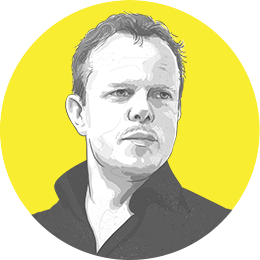Every design journey starts somewhere. Design of a new concept, design of a brand new company or a new direction for your company to stay ahead of competition. In every case, the journey you take will start with a point of view. But how do you design one? Learn from a new tool that help you design your vision or point of view (POV).
Whether it is about a market, or a customer, or a new product or service, or even a competitor, we all have a point of view. Being at the center of the design journey, your point of view (POV) is your most valuable asset. It provides the litmus test for what’s real and what’s just a mirage. As a designer you are responsible for actively shaping your point of view based on what you learn along the way. So how you do that?
THE FIRST STEP IS ALWAYS THE HARDEST
Developing new business ideas from scratch can seem like a daunting task. When you’re a startup, you have hope in your heart that your company will become the big thing. You work hard at developing and selling your product – but often, the harder you work, the farther away your away dreams seem to be. When you’re an established business, you’ve been driving the same executional strategy for many, many years. Your shareholders enjoy the fruits of your labor in the form of increasing share prices and dividends, and your board looks to past growth for future strategy. However these past successes may become a burden as you try to steer your company into new waters.
To create change, you must start with your point of view, even when the odds seemed stacked against you. Maybe you’re thinking, “But it’s just my point of view! What changes could I possibly make based on what I think?!” You wouldn’t be wrong – or the first person – to think this. However, when you pair your point of view with specific tools, skills, and a mindset to match, you can absolutely create the change you’re looking for.
BE A REBEL
If you’re looking to influence someone, especially someone you need on your team to turn your point of view into a successful strategy, it may sound counterintuitive to say that you should be a rebel. But, it’s precisely the rebel, and the points of view that she brings with her, that will serve as the catalyst for change. Being a rebel does not mean you must go against everything that your company or leadership stand for. Rather, being a rebel is about coming to the table with a strong point of view toward the future. You do not need to buck the establishment – but you do need to question the establishment and bring to the table those big ideas that you feel in your gut are worth exploring.
LET YOUR VISION BE YOUR ROADMAP
A strong point of view will serve as your catalyst for change. It is your vision for the future that will serve as the roadmap leading to the change you seek to make. People argue their points of view over beers. Visions set direction (maybe so that you can buy even more beer with the money you’ll make in the future!). Our definition of “vision” is different than what you’ll find in other books or articles. It’s not just a statement; it’s a rally cry.
The concept of vision is all-encompassing; it includes the supporting factors that make the vision real, the steps you need to take to realize the vision, and the challenges and opportunities that you’ll face on your way to achieving your vision. To make your vision tangible and useful, the chapter Point Of View lays out co-creative tools that you can – and should – use with your team.
DESIGN YOUR STORY WITH THE 5 BOLD STEPS VISION CANVAS
When you enter that boardroom, or strategy meeting, or VC pitch, what are you going to say? How will you sway people to your point of view, or at least convince them to explore with you? This is where stories make a big difference. Ever notice how the best speakers, whether giving a TED talk, presenting in a conference room, or holding court in a bar, use anecdotes and stories to convey the points they are making? Though naturally talented speakers may do this somewhat instinctively, anyone who does this well is deliberate about what stories they tell, how, when, and to whom. To make your mark and gain the buy-in you’ll need to explore your point of view. In other words, you’ll need to design your story!
But don’t let that worry you. We are giving you new tools: Check out The Five Bold Steps Vision Canvas in the DESIGN A BETTER BUSINESS TOOLBOX

